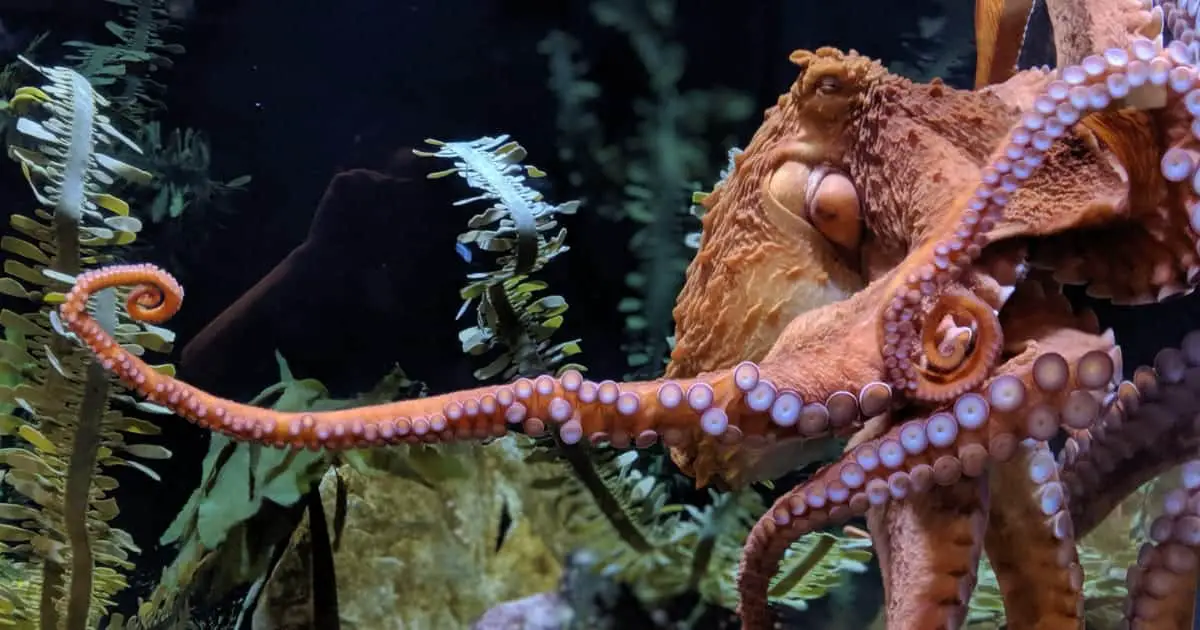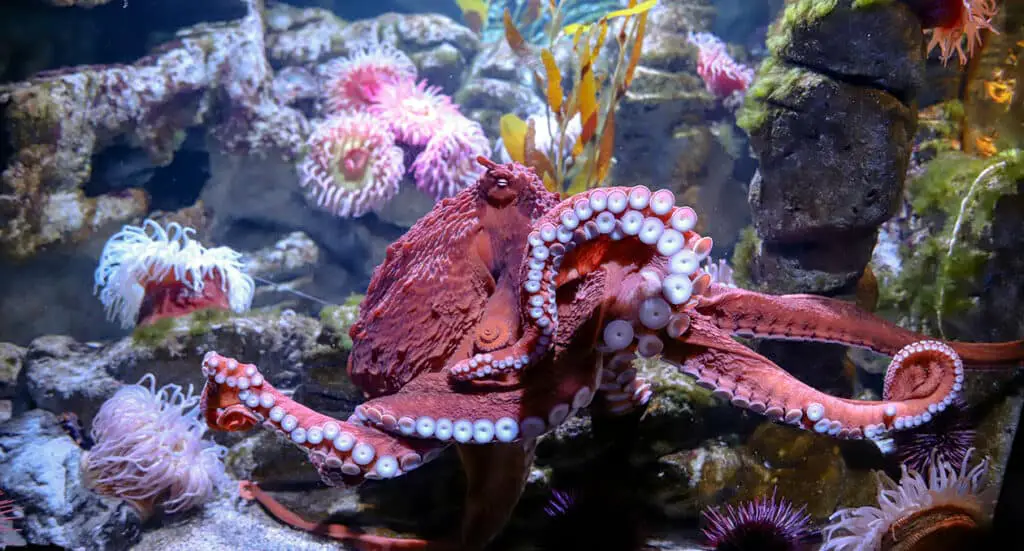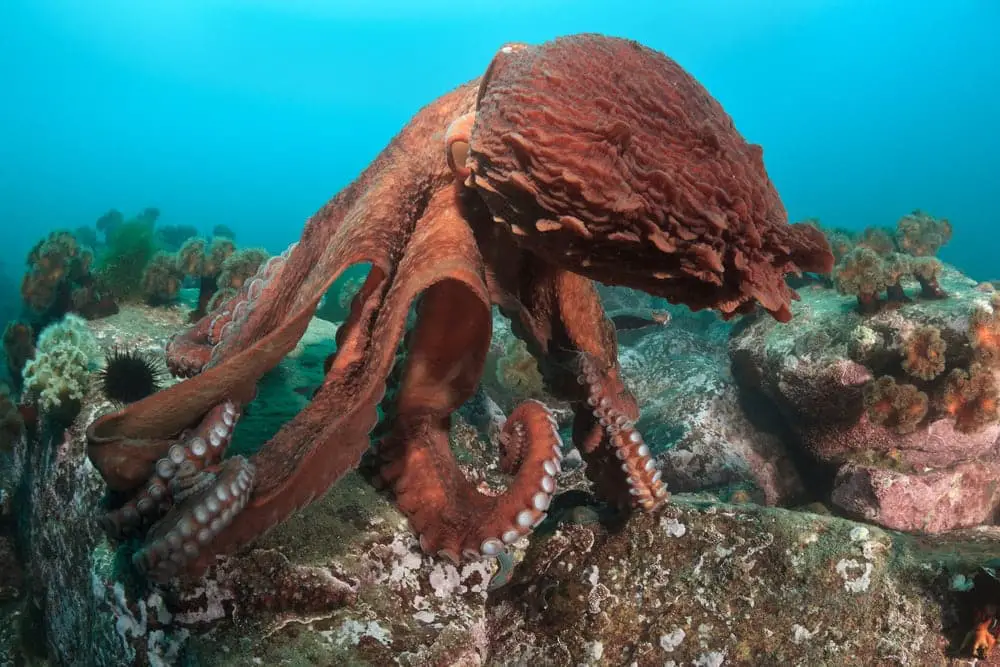What Do Giant Pacific Octopus Eat

Introduction
What Do Giant Pacific Octopus Eat: The Giant Pacific Octopus, scientifically known as Enteroctopus dofleini, is a fascinating marine creature that inhabits the vast and diverse waters of the North Pacific Ocean. Renowned for its immense size, remarkable intelligence, and incredible adaptability, this species of octopus has long captured the imagination of marine biologists and enthusiasts alike.
Understanding what Giant Pacific Octopuses eat provides valuable insights into their ecological role and survival strategies. These cephalopods are opportunistic predators with a remarkably diverse palate. Their diet primarily consists of crustaceans like crabs and shrimps, mollusks such as clams and snails, and various species of fish.
What sets Giant Pacific Octopuses apart from many other marine creatures is their ability to adapt to different prey availability in their environment. When these octopuses are small, they often feed on tiny prey like copepods and small crabs. As they grow larger, they expand their menu to include larger prey items, such as fish and larger crustaceans.
This adaptability in their diet is a testament to the remarkable versatility of the Giant Pacific Octopus, allowing them to thrive in a variety of marine ecosystems. It also underscores the importance of these creatures in maintaining the balance of their underwater habitats. Studying what Giant Pacific Octopuses eat helps scientists gain a deeper understanding of the intricate relationships within marine food webs and highlights the critical role these intelligent cephalopods play in the marine ecosystem.

Do giant Pacific octopus eat sharks?
Diet and Range
They hunt at night, surviving primarily on shrimp, clams, lobsters, and fish, but have been known to attack and eat sharks as well as birds, using their sharp, beaklike mouths to puncture and tear flesh.
Giant Pacific Octopuses do not typically eat sharks as a primary part of their diet. These octopuses are known for their diverse and opportunistic feeding habits, but sharks are not a common prey item. While they have been observed to consume small sharks on rare occasions, it is not a regular or significant part of their diet.
Giant Pacific Octopuses primarily feed on a variety of marine creatures such as crabs, clams, snails, fish, and other mollusks. Their diet is highly dependent on what is available in their habitat and their size. When they are small, they mainly consume smaller prey like copepods and tiny crustaceans, gradually transitioning to larger prey items as they grow.
Sharks are generally larger and more powerful than the typical prey of the Giant Pacific Octopus. While octopuses are known for their intelligence and adaptability, capturing and subduing a shark is a formidable challenge and a rare occurrence. Sharks are also apex predators in the ocean, occupying a high position in the food chain, whereas octopuses are more often prey for larger predators like sharks and seals.
How much does a giant Pacific octopus eat?
In the wild, their rocky dens can be recognized by the piles of discarded shells just outside the entrances. Giant Pacific octopuses can consume 2–4% and gain 1–2% of their body weight each day. That’s the equivalent of a 150-pound person eating up to six pounds of food and gaining up to three pounds every single day!
The dietary requirements of a Giant Pacific Octopus, like most organisms, vary depending on several factors, including its size, age, and environmental conditions. Generally, these octopuses are voracious eaters, and their appetite increases as they grow larger.
Younger, smaller Giant Pacific Octopuses have more modest feeding habits, consuming smaller prey items like tiny crustaceans and small fish. As they mature and their size increases, so does their food intake. Adult Giant Pacific Octopuses are known to eat more substantial meals, which can include larger crustaceans, mollusks, and a wider variety of fish species. Their powerful beaks and flexible tentacles allow them to capture, subdue, and dismember their prey efficiently.
In captivity, where their food supply is controlled, it’s not uncommon for an adult Giant Pacific Octopus to consume several pounds of food per week. In the wild, their feeding frequency and the quantity of food they consume can vary based on the availability of prey in their habitat and their energy needs for activities like hunting, reproduction, and maintaining health.
Overall, the dietary habits of a Giant Pacific Octopus are adaptable, reflecting their ability to thrive in diverse marine environments. Their diet plays a vital role in regulating the populations of various marine species, contributing to the balance and health of their ecosystems.
Do giant Pacific octopus eat shrimp?
Giant Pacific octopuses spend most of their lives alone. They hunt at night for shrimp, clams, lobsters and fish, but have also been known to eat small sharks using their beak-like mouths to puncture prey. Along with eight arms, an octopus also has three hearts and nine brains.
Giant Pacific Octopuses do indeed eat shrimp. Shrimp are a common and readily available prey item in the diet of these cephalopods. These octopuses are known for their diverse and opportunistic feeding habits, and shrimp are among the many crustaceans that they frequently consume.
Shrimp make for a suitable meal for Giant Pacific Octopuses, especially when they are small or as part of their diet as they grow larger. Their flexible tentacles and strong beaks enable them to capture and subdue shrimp effectively. They can hunt for shrimp both in the open water and within the crevices and rocky outcrops of their coastal habitats.
While shrimp are a regular part of their diet, Giant Pacific Octopuses also consume a variety of other marine organisms, including crabs, clams, snails, fish, and other mollusks. Their adaptability and ability to exploit different food sources contribute to their success as predators in their marine ecosystems.
Shrimp are indeed on the menu for Giant Pacific Octopuses, showcasing the versatility and opportunistic nature of their feeding habits as they forage for a wide range of prey to satisfy their dietary needs.
What does octopus eat?
Adult octopuses feed on crabs, clams, snails, small fishes, and even other octopuses. All species of octopus have venom of varying levels of toxicity, which they inject using a beak that is similar to a bird’s. They typically hunt at night, pouncing on their prey and wrapping it in the webbing between their arms.
Octopuses are carnivorous predators with a highly varied diet, showcasing their adaptability to different marine environments. What an octopus eats depends on its species, size, and the availability of prey in its habitat.
A common component of an octopus’s diet is crustaceans, which include crabs, shrimp, and lobsters. These crustaceans are often a favored prey due to their availability and nutritional value. Octopuses use their powerful beaks to crush the shells of crustaceans before consuming them.
Mollusks, such as clams, snails, and various shellfish, are another staple in the octopus diet. Octopuses are skilled hunters and use their dexterous tentacles to pry open shells and access the soft flesh inside.
Fish make up a significant part of the diet for many octopus species. Some octopuses are known to engage in active hunting, chasing and capturing fish, while others use stealth and camouflage to ambush their prey.
Octopuses are opportunistic feeders and will consume whatever is available and appropriately sized in their environment. This adaptability extends to their willingness to consume other cephalopods, small marine animals, and even occasional detritus.
The diet of an octopus is remarkably diverse, reflecting its ability to exploit various food sources in its underwater world. This dietary adaptability plays a crucial role in their survival and underscores their significance in maintaining the balance of marine ecosystems.
What do Giant Pacific Octopus need to survive?
One element all these places need for a Giant Pacific Octopus to call it home: cool, richly oxygenated waters. Kelp forests, rocky reefs, shallow tidal pools, and depths down to 100 meters (330 feet) are just some of the marine environments you might find a GPO.
For a Giant Pacific Octopus (Enteroctopus dofleini) to thrive and survive, several essential factors and conditions must be met:
- Habitat: These octopuses are primarily found in the cold, rocky coastal waters of the North Pacific Ocean. They require a suitable habitat with crevices, caves, and rocky substrates where they can hide, rest, and hunt for prey. A proper habitat offers protection from predators and a safe place to lay eggs.
- Water Quality: Octopuses are sensitive to changes in water quality. Clean and well-oxygenated seawater is crucial for their survival. Pollution, temperature extremes, and ocean acidification can all negatively impact their health and habitat.
- Diet: Giant Pacific Octopuses are carnivorous and require a varied diet of crustaceans, mollusks, fish, and other marine organisms. Access to an abundant and diverse food supply is essential for their survival and growth.
- Reproduction: Successful reproduction is vital for the continuation of the species. Female octopuses need a safe place to lay their eggs, typically in a den or crevice, and they guard and care for their eggs until they hatch. Ensuring suitable conditions for reproduction is critical.
- Predator Avoidance: Giant Pacific Octopuses have various predators, including sharks, seals, and larger fish. Their survival depends on their ability to hide, use camouflage effectively, and employ their intelligence to avoid or escape from threats.
- Temperature Regulation: Octopuses are ectothermic, meaning they rely on their environment to regulate their body temperature. Maintaining a suitable water temperature is crucial for their metabolic processes and overall well-being.
The survival of Giant Pacific Octopuses relies on a combination of suitable habitat, clean water, an adequate diet, successful reproduction, predator avoidance, and appropriate temperature conditions. Protecting their natural habitats and the health of marine ecosystems is essential for the long-term survival of these intriguing and ecologically significant creatures.
How do octopus take in food?
They typically hunt at night, pouncing on their prey and wrapping it in the webbing between their arms. They penetrate hard-shelled prey with their beaks.
Octopuses have a unique and highly efficient way of taking in food. Their feeding process is a fascinating display of their intelligence and adaptability.
- Detection: Octopuses are skilled hunters with keen senses. They use their excellent eyesight to spot prey, but they also have an acute sense of smell and touch. Chemoreceptors in their suckers help them detect chemical signals and locate potential food sources.
- Capture: Once they’ve identified prey, octopuses use their powerful and flexible tentacles to capture it. Their suckers are equipped with sensory organs, enabling them to assess the texture, size, and edibility of the item they’ve grabbed.
- Subduing: Octopuses often need to immobilize their prey before consumption. Some species use venomous bites to paralyze or kill their prey, while others employ brute strength to subdue it.
- Manipulation: Octopuses are incredibly dexterous. They can manipulate their food with precision using their strong arms, bringing it closer to their beak, which is located at the center of their arms.
- Feeding: The octopus’s beak is a sharp, parrot-like structure that they use to break down the prey’s hard parts, like shells or exoskeletons. They can pierce and tear apart the prey, ensuring it’s small enough to be ingested.
Octopuses are opportunistic feeders and can adjust their feeding strategies depending on the prey and the circumstances. This remarkable feeding process highlights their adaptability and resourcefulness in securing the nourishment they need to survive and thrive in their marine environments.
Can a giant Pacific octopus survive out of water?
Unlike most fish, octopus have no swim bladders, so they are less likely to be injured by pressure changes when brought up from ocean depths. Octopus can survive out of water for brief periods. Fishery observers have reported that most octopus are alive when released from pot gear.
A Giant Pacific Octopus cannot survive out of water for an extended period. These octopuses, like all cephalopods, are marine animals that depend on the ocean’s environment to support their respiration, temperature regulation, and overall well-being.
Giant Pacific Octopuses have gills, which enable them to extract oxygen from the water. When out of water, their gills quickly dry out, making it impossible for them to breathe. Without a constant supply of oxygen, they would suffocate.
Octopuses have evolved to thrive in the buoyancy of water, and their body structure is not adapted for terrestrial locomotion. On land, their soft bodies are vulnerable to injury, and they lack the support and protection they have in the water.
While Giant Pacific Octopuses are highly adaptable and can survive brief excursions out of water, such as when hunting along intertidal zones or crossing short distances between tide pools, they cannot endure extended periods away from their aquatic habitat. Their ability to move on land is limited, and they are susceptible to desiccation (drying out) and other stressors.
How much can a giant Pacific octopus lift?
Each octopus arm can have over 200 suckers- each with the ability to taste, grip, and lift 14 kg (31 lbs). In theory, an octopus could lift more than 22,400 kg (over 49,000 lbs) using all its suckers! Males can be distinguished from females by a distinct third right arm, called a hectocotylus.
The lifting capacity of a Giant Pacific Octopus, like that of most octopuses, is quite limited. These creatures are highly adapted to their aquatic environment, where buoyancy supports their bodies. On land or in the air, they lack the structural support and muscle strength required for heavy lifting.
Octopuses have a soft, gelatinous body composed mainly of muscle and connective tissue. Their strength is primarily used for activities within the water, such as swimming, hunting, and manipulating objects in their environment. They are incredibly dexterous, capable of delicate and precise movements with their flexible arms and suckers.
While octopuses can exert force to capture and manipulate prey, they do not possess the physical adaptations for lifting heavy objects like humans or some other animals. Their soft bodies and lack of a rigid skeleton make lifting and carrying objects out of water nearly impossible for them.

Conclusion
The dietary preferences and feeding habits of the Giant Pacific Octopus, Enteroctopus dofleini, reveal the incredible adaptability and versatility of this remarkable marine species. With a diverse menu that includes crustaceans, mollusks.
The Giant Pacific Octopus’s opportunistic nature allows it to exploit various food sources, making it a vital component of marine food webs. By controlling populations of prey species, they help maintain ecosystem balance and health. Their ability to capture prey with their powerful beaks and agile tentacles showcases their remarkable hunting prowess.
Understanding what Giant Pacific Octopuses eat is not only crucial for ecological research but also underscores the need for conservation efforts to protect these intriguing creatures and their habitats. Human activities, such as overfishing and habitat destruction, can disrupt the delicate balance of marine ecosystems, potentially impacting the octopus’s food sources and overall survival.
The dietary habits of the Giant Pacific Octopus serve as a microcosm of the intricate web of life beneath the waves. Their adaptability, intelligence, and role as both predator and prey remind us of the interconnectedness of all marine life and the importance of safeguarding the oceans for the benefit of these incredible creatures and future generations.



